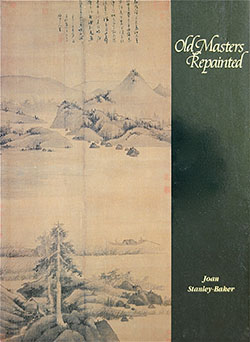Authenticity and connoisseurship
From masterpieces to schools
 | |
| Joan STANLEY-BAKER Old Masters Repainted Hong Kong University Press, 1995. | |
By contrast to masterpieces, one may look for 'prime objects'. These are works that have 'highly likely' attributions, often on account of documentary evidence of provenance, or contemporary supporting inscriptions (which themselves appear to match known examples.) The actual quality of a prime object may not be as remarkable as other paintings ascribed to a painter, but it can provide a significant reference point. This approach has been extensively considered by the so-called Princeton School of Chinese art history, associated with Wen Fong. Joan STANLEY-BAKER's Old Masters Repainted (1995) considers this in respect to the Yuan painter WU Zhen 吳鎮 (1280-1354) and she concludes that in the case of his work – and many later Ming and Qing painters – that later copies have been confused with the works of the original master. This, of course, dilutes and muddies understanding of the master.
The difficulty with the prime object approach is that there are often too few 'highly likely' examples to work from, so that the full range of a painter's work may not be apparent from the small number of sure examples. This is especially important where an artist is known to have worked in several styles or formats and with different kinds of brushes and on both paper and silk. In this respect, experience of a larger volume of 'moderately reliable' work associated with the painter may give one a better appreciation of a range of 'standard' or 'typical' performance.
To a certain extent this experience can be developed from viewing published materials. Regrettably, while there are lengthy accounts of a handful of individuals, there are no proper catalogue raisonnés of pre-modern Chinese artists. In the area of Chinese publishing, there are a limited number of incomplete, large format books covering a few dozen individual artists prior to 1900. There are also occasional exhibition catalogues, but these are limited in scope and print run (usually with a narrow selection of paintings relating to a particular theme or available for loan.)
Auctions and their catalogues play a useful role in bringing a larger volume of typical examples to view. If these are used judiciously – focusing on the more expensive offerings where quality and attribution are usually higher – these can be used to extend one's appreciation of an artist's career oeuvre.